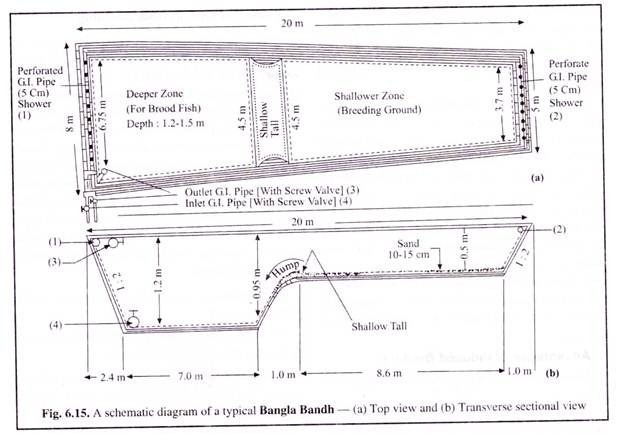The below mentioned article provides short notes on Bangla Bundh.
Bangla bundh are basically a small dry type of bundh that can be built up at a suitable site on any type of soil. It has been improvised by the fisheries department of West Bengal for massive breeding of major carps. It is constructed in a fish farm along with breeding pool and Chinese hatchery, where massive induced breeding is undertaken.
The Bangla Bundh (Fig. 6.15) is generally ‘Trapezoidal shaped’ having an area of 0.01-0.2 ha, which is sufficient to produce about 2-5 million eggs in every successful operation. 10-15 such operations in a season may result in the production of 20-40 million eggs.
The Bangla Bundh is a masonry construction with inlet and outlet systems. Half of the area of the bundh is shallow and the rest is deep, with the outlet being present in the deepest area for complete drainage of water. The water depth of the shallow zone is maintained at 30-50 cm and that of the deeper zone at 80-100 cm.
ADVERTISEMENTS:
The transverse and longitudinal slopes of the tank floor are so constructed so as to create and maintain a feeble water current just like that of a river. The water supply to the bundh is through a tube-well which is pumped into an overhead tank. A showering system is present for oxygenation and cooling the water.
Prior to the introduction of water into the bundh, a thin layer of fresh sand is uniformly spread over the shallower zone to facilitate natural breeding by simulating riverine conditions.
A bump separates shallower zone from the deeper one and prevents escape of sand from the breeding ground to the deeper zone. 50 kg of spawner can be introduced in the bundh at a time. The deeper zone of the bundh gets filled first with clean water of the overhead tank.
ADVERTISEMENTS:
The brooders after the 2nd injection of the spawners (female) and the only injection of the mitters (males), are released into this deeper zone. The running water condition and the showering system are then maintained for about 3-4 hours. After this the males start chasing the females and they move into the shallower areas of the bundh.
The male and female are seen to bend their bodies around each other during their courtship behaviour. This act exerts pressure on the abdomen of the mating pair resulting in the extrusion of ova and exudation of milt. The spent fishes then move to the deeper areas of the bundh.
Fertilisation takes place and the fertilised eggs are left for 4 hours for water hardening. They are then collected with the help of a chot jal into a hundi and then transferred to the Chinese hatcheries.
